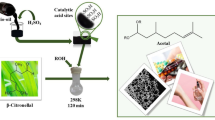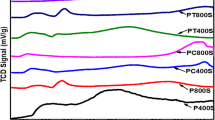Abstract
The reaction of acetone with glycerol to yield 2,2-dimethyl-1,3-dioxolane-4-methanol (solketal) was successfully catalyzed by a novel, sustainable solid acid catalyst formed by the hydrothermal carbonization (HTC) of carrageenan, a sulfated natural polysaccharide obtained from red macroalgae. All evaluated carrageenan HTC material incorporated some sulfur atoms on their structure, leading to remarkable strong acidity, in the range of 1.26 to 1.29 mmol g−1, depending on the time of HTC. The glycerol conversion was around 80–85% within 1 h and 95–98% within 6 h, similar to Amberlyst-15 and better than many commercial solid acids. These results were interpreted in terms of the formation of strong acid sites, probably of sulfonic acid nature present in low concentration, as shown by FTIR. The carrageenan HTC materials showed excellent activity and stability, being truly heterogeneous catalysts that can be reused without significant deactivation. These results indicate the potential of these materials as sustainable acid catalysts, especially for the conversion of biomass.
Graphical abstract
A new sustainable acid catalyst was developed upon the HTC of carrageenan, a natural sulfated polysaccharide, avoiding further sulfonation of the hydrochar.








Similar content being viewed by others
References
Perego C, Bosetti A (2011) Biomass to fuels: the role of zeolite and mesoporous materials. Microporous Mesoporous Mater 144:28–39. https://doi.org/10.1016/j.micromeso.2010.11.034
White RJ, Budarin V, Luque R et al (2009) Tuneable porous carbonaceous materials from renewable resources. Chem Soc Rev 38:3401–3418. https://doi.org/10.1039/b822668g
Quignard F, Valentin R, Di Renzo F (2008) Aerogel materials from marine polysaccharides. New J Chem 32:1300–1310. https://doi.org/10.1039/b808218a
Quignard F, Choplin A, Domard A (2000) Chitosan: a natural polymeric support of catalysts for the synthesis of fine chemicals. Langmuir 16:9106–9108. https://doi.org/10.1021/la000937d
Hara M, Yoshida T, Takagaki A et al (2004) A carbon material as a strong protonic acid. Angew Chemie - Int Ed 43:2955–2958. https://doi.org/10.1002/anie.200453947
Onda A, Ochi T, Yanagisawa K (2009) Hydrolysis of cellulose selectively into glucose over sulfonated activated-carbon catalyst under hydrothermal conditions. Top Catal 52:801–807. https://doi.org/10.1007/s11244-009-9237-x
Kitano M, Yamaguchi D, Suganuma S et al (2009) Adsorption-enhanced hydrolysis of /?-1,4-glucan on graphene-based amorphous carbon bearing so3H, COOH, and OH groups. Langmuir 25:5068–5075. https://doi.org/10.1021/la8040506
Gong R, Ma Z, Wang X et al (2019) Sulfonic-acid-functionalized carbon fiber from waste newspaper as a recyclable carbon based solid acid catalyst for the hydrolysis of cellulose. RSC Adv 9:28902–28907. https://doi.org/10.1039/c9ra04568f
Ji J, Zhang G, Chen H et al (2011) Sulfonated graphene as water-tolerant solid acid catalyst. Chem Sci 2:484–487. https://doi.org/10.1039/c0sc00484g
Sevilla M, Fuertes AB (2009) The production of carbon materials by hydrothermal carbonization of cellulose. Carbon N Y 47:2281–2289. https://doi.org/10.1016/j.carbon.2009.04.026
Simsir H, Eltugral N, Karagoz S (2017) Hydrothermal carbonization for the preparation of hydrochars from glucose, cellulose, chitin, chitosan and wood chips via low-temperature and their characterization. Bioresour Technol 246:82–87. https://doi.org/10.1016/j.biortech.2017.07.018
Titirici MM, Antonietti M, Baccile N (2008) Hydrothermal carbon from biomass: a comparison of the local structure from poly- to monosaccharides and pentoses/hexoses. Green Chem 10:1204–1212. https://doi.org/10.1039/b807009a
Titirici MM, White RJ, Falco C, Sevilla M (2012) Black perspectives for a green future: hydrothermal carbons for environment protection and energy storage. Energy Environ Sci 5:6796–6822. https://doi.org/10.1039/c2ee21166a
Liu F, Yu R, Ji X, Guo M (2018) Hydrothermal carbonization of holocellulose into hydrochar: Structural, chemical characteristics, and combustion behavior. Bioresour Technol 263:508–516. https://doi.org/10.1016/j.biortech.2018.05.019
Song XL, Fu XB, Zhang CW et al (2012) Preparation of a novel carbon based solid acid catalyst for biodiesel production via a sustainable route. Catal Letters 142:869–874. https://doi.org/10.1007/s10562-012-0840-2
Zhang W, Tao H, Zhang B et al (2011) One-pot synthesis of carbonaceous monolith with surface sulfonic groups and its carbonization/activation. Carbon N Y 49:1811–1820. https://doi.org/10.1016/j.carbon.2010.12.050
Sanderson JC, Dring MJ, Davidson K, Kelly MS (2012) Culture, yield and bioremediation potential of Palmaria palmata (Linnaeus) Weber & Mohr and Saccharina latissima (Linnaeus) C.E. Lane, C. Mayes, Druehl & G.W. Saunders adjacent to fish farm cages in northwest Scotland. Aquaculture 354–355:128–135. https://doi.org/10.1016/j.aquaculture.2012.03.019
Dodson JR, Budarin VL, Hunt AJ et al (2013) Shaped mesoporous materials from fresh macroalgae. J Mater Chem A 1:5203–5207. https://doi.org/10.1039/c3ta10568g
Yu G, Guan H, Ioanoviciu AS et al (2002) Structural studies on κ-carrageenan derived oligosaccharides. Carbohydr Res 337:433–440. https://doi.org/10.1016/S0008-6215(02)00009-5
da Silva CXA, Gonçalves VLC, Mota CJA (2009) Water-tolerant zeolite catalyst for the acetalisation of glycerol. Green Chem 11:38–41. https://doi.org/10.1039/b813564a
Dodson JR, Leite TDCM, S. Pontes N, et al (2014) Green acetylation of solketal and glycerol formal by heterogeneous acid catalysts to form a biodiesel fuel additive. ChemSusChem 7https://doi.org/10.1002/cssc.201402070
Mota CJA, Da Silva CXA, Rosenbach N et al (2010) Glycerin derivatives as fuel additives: the addition of glycerol/acetone ketal (solketal) in gasolines. Energy Fuels 24:2733–2736. https://doi.org/10.1021/ef9015735
Mota CJA, Pinto BP, de Lima AL (2017) Glycerol: a versatile renewable feedstock for the chemical industry
Alptekin E, Canakci M (2017) Performance and emission characteristics of solketal-gasoline fuel blend in a vehicle with spark ignition engine. Appl Therm Eng 124:504–509. https://doi.org/10.1016/j.applthermaleng.2017.06.064
Rossa V, Pessanha YDSP, Díaz GC et al (2017) Reaction kinetic study of solketal production from glycerol ketalization with acetone. Ind Eng Chem Res 56:479–488. https://doi.org/10.1021/acs.iecr.6b03581
Ilgen O, Yerlikaya S, Akyurek FO (2017) Synthesis of solketal from glycerol and acetone over amberlyst-46 to produce an oxygenated fuel additive. Period Polytech Chem Eng 61:144–148. https://doi.org/10.3311/PPch.8895
Li R, Song H, Chen J (2018) Propylsulfonic acid functionalized sba-15 mesoporous silica as efficient catalysts for the acetalization of glycerol. Catalysts 8https://doi.org/10.3390/catal8080297
Oliveira PA, Souza ROMA, Mota CJA (2016) Atmospheric pressure continuous production of solketal from the acid-catalyzed reaction of glycerol with acetone. J Braz Chem Soc 27:1832–1837. https://doi.org/10.5935/0103-5053.20160066
Vicente G, Melero JA, Morales G et al (2010) Acetalisation of bio-glycerol with acetone to produce solketal over sulfonic mesostructured silicas. Green Chem 12:899–990. https://doi.org/10.1039/b923681c
Goertzen SL, Thériault KD, Oickle AM et al (2010) Standardization of the Boehm titration. Part I. CO2 expulsion and endpoint determination. Carbon N Y 48:1252–1261. https://doi.org/10.1016/j.carbon.2009.11.050
Oickle AM, Goertzen SL, Hopper KR et al (2010) Standardization of the Boehm titration: Part II. Method of agitation, effect of filtering and dilute titrant. Carbon N Y 48:3313–3322. https://doi.org/10.1016/j.carbon.2010.05.004
Okamura M, Takagaki A, Toda M et al (2006) Acid-catalyzed reactions on flexible polycyclic aromatic carbon in amorphous carbon. Chem Mater 18:3039–3045. https://doi.org/10.1021/cm0605623
Baccile N, Laurent G, Babonneau F et al (2009) Structural characterization of hydrothermal carbon spheres by advanced solid-state MAS 13C NMR investigations. J Phys Chem C 113:9644–9654. https://doi.org/10.1021/jp901582x
Johnson RL, Anderson JM, Shanks BH et al (2013) Spectrally edited 2D 13C–13C NMR spectra without diagonal ridge for characterizing 13C-enriched low-temperature carbon materials. J Magn Reson 234:112–124. https://doi.org/10.1016/j.jmr.2013.06.006
Lee D (2013) Preparation of a sulfonated carbonaceous material from lignosulfonate and its usefulness as an esterification catalyst. Molecules 18:8168–8180. https://doi.org/10.3390/molecules18078168
Ma F, Hanna MA (1999) Biodiesel production: a review1Journal Series #12109, Agricultural Research Division, Institute of Agriculture and Natural Resources, University of Nebraska-Lincoln. 1. Bioresour Technol 70:1–15. https://doi.org/10.1016/s0960-8524(99)00025-5
Li L, Korányi TI, Sels BF, Pescarmona PP (2012) Highly-efficient conversion of glycerol to solketal over heterogeneous Lewis acid catalysts. Green Chem 14:1611–1619. https://doi.org/10.1039/c2gc16619d
Rodrigues R, Gonçalves M, Mandelli D et al (2014) Solvent-free conversion of glycerol to solketal catalysed by activated carbons functionalised with acid groups. Catal Sci Technol 4:2293–2301. https://doi.org/10.1039/c4cy00181h
Suriyaprapadilok N, Kitiyanan B (2011) Synthesis of solketal from glycerol and its reaction with benzyl alcohol. Energy Procedia 9:63–69. https://doi.org/10.1016/j.egypro.2011.09.008
Li X, Zheng L, Hou Z (2018) Acetalization of glycerol with acetone over Co[II](Co[III]xAl2−x)O4 derived from layered double hydroxide. Fuel 233:565–571. https://doi.org/10.1016/j.fuel.2018.06.096
Li X, Jiang Y, Zhou R, Hou Z (2019) Layered α-zirconium phosphate: an efficient catalyst for the synthesis of solketal from glycerol. Appl Clay Sci 174:120–126. https://doi.org/10.1016/j.clay.2019.03.034
Li X, Jiang Y, Zhou R, Hou Z (2020) Acetalization of glycerol with acetone over appropriately-hydrophobic zirconium organophosphonates. Appl Clay Sci 189:105555. https://doi.org/10.1016/j.clay.2020.105555
Zhou R, Jiang Y, Zhao H et al (2021) Synthesis of solketal from glycerol over modified SiO2 supported p-phenolsulfonic acid catalyst. Fuel 291:1–9. https://doi.org/10.1016/j.fuel.2021.120207
Nandan D, Sreenivasulu P, SivakumarKonathala LN et al (2013) Acid functionalized carbon-silica composite and its application for solketal production. Microporous Mesoporous Mater 179:182–190. https://doi.org/10.1016/j.micromeso.2013.06.004
Gonçalves M, Rodrigues R, Galhardo TS, Carvalho WA (2016) Highly selective acetalization of glycerol with acetone to solketal over acidic carbon-based catalysts from biodiesel waste. Fuel 181:46–54. https://doi.org/10.1016/j.fuel.2016.04.083
Khayoon MS, Hameed BH (2013) Solventless acetalization of glycerol with acetone to fuel oxygenates over Ni-Zr supported on mesoporous activated carbon catalyst. Appl Catal A Gen 464–465:191–199. https://doi.org/10.1016/j.apcata.2013.05.035
da Silva CXA, Mota CJA (2011) The influence of impurities on the acid-catalyzed reaction of glycerol with acetone. Biomass Bioenerg 35:3547–3551. https://doi.org/10.1016/j.biombioe.2011.05.004
Nair GS, Adrijanto E, Alsalme A et al (2012) Glycerol utilization: solvent-free acetalisation over niobia catalysts. Catal Sci Technol 2:1173–1179. https://doi.org/10.1039/c2cy00335j
Ozorio LP, Pianzolli R, Mota MBS, Mota CJA (2012) Reactivity of glycerol/acetone ketal (solketal) and glycerol/formaldehyde acetals toward acid-catalyzed hydrolysis. J Braz Chem Soc 23:931–937. https://doi.org/10.1590/S0103-50532012000500019
Hu JZ, Solum MS, Taylor CMV et al (2001) Structural’determination in carbonaceous solids using advanced solid state NMR techniques. Energy Fuels 15:14–22. https://doi.org/10.1021/ef0001888
Fernández P, Fraile JM, García-Bordejé E, Pires E (2019) Sulfonated hydrothermal carbons from cellulose and glucose as catalysts for glycerol ketalization. Catalysts 9https://doi.org/10.3390/catal9100804
Anderson JM, Johnson RL, Schmidt-Rohr K, Shanks BH (2014) Hydrothermal degradation of model sulfonic acid compounds: probing the relative sulfur-carbon bond strength in water. Catal Commun 51:33–36. https://doi.org/10.1016/j.catcom.2014.03.021
Crotti C, Farnetti E, Guidolin N (2010) Alternative intermediates for glycerol valorization: iridium-catalyzed formation of acetals and ketals. Green Chem 12:2225–2231. https://doi.org/10.1039/c0gc00096e
Chandrasekhar S (1987) Product stability in kinetically-controlled organic reactions. Chem Soc Rev 16:313–338. https://doi.org/10.1039/CS9871600313
Acknowledgements
Authors acknowledge FAPERJ, CAPES, and CNPq for financial support and Agargel for kindly donating the carrageenan sample. JRD thanks FAPERJ for a fellowship.
Author information
Authors and Affiliations
Corresponding author
Ethics declarations
Conflict of interest
The authors declare no competing interests.
Additional information
Publisher's Note
Springer Nature remains neutral with regard to jurisdictional claims in published maps and institutional affiliations.
Rights and permissions
About this article
Cite this article
Mota, C.J.A., Dodson, J.R., Pinto, B.P. et al. Sustainable acid catalyst from the hydrothermal carbonization of carrageenan: use in glycerol conversion to solketal. Biomass Conv. Bioref. 13, 12009–12019 (2023). https://doi.org/10.1007/s13399-021-02029-0
Received:
Revised:
Accepted:
Published:
Issue Date:
DOI: https://doi.org/10.1007/s13399-021-02029-0




